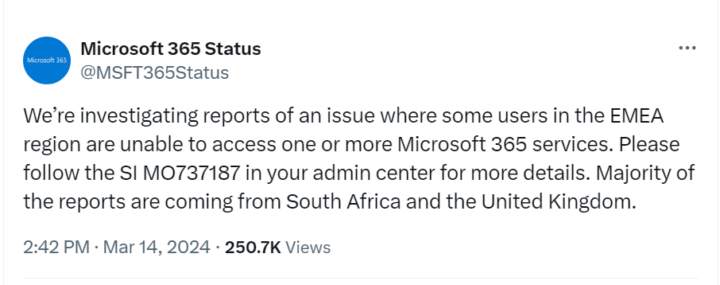Microsoft Services Disruptions Across Africa
Major Cable Cut Disrupts Microsoft Services Across Africa Highlighting Cloud Risk and Disaster Recovery Needs with ISO Standards Guidance

Nairobi, Kenya – 14th March 2024 – A widespread outage caused by undersea cables cut caused significant disruptions to Microsoft services across Africa, leaving businesses and individuals struggling to access crucial cloud-based applications. This incident underscores the growing reliance on cloud services and the importance of robust cloud risk management and disaster recovery planning, aligned with international standards like ISO 27001:2022 and ISO 22301.
Undersea Cable Woes and Cloud Disruption
Reports on social media and outage tracking websites like Downdetector indicated issues with popular Microsoft services like Microsoft 365, Teams, and Azure. The outage was caused by a disruption to the undersea cables connecting Africa to Europe and the Middle East, highlights the potential vulnerabilities of cloud-based systems. These cables are the backbone of internet connectivity for much of the continent, and disruptions can have a cascading effect, impacting various online services.

The Importance of Cloud Risk Assessment and Disaster Recovery
The service outage serves as a stark reminder for organizations of all sizes that leverage cloud services. Here’s why a proactive approach to cloud risk management and disaster recovery planning is crucial:
- Mitigating Disruption: A comprehensive cloud risk assessment helps identify potential threats specific to cloud environments, such as outages, data breaches, and vendor lock-in. By understanding these risks, organizations can implement mitigation strategies to minimize disruption.
- Business Continuity: Developing a robust disaster recovery plan ensures a swift and efficient recovery process in case of cloud outages. This plan should outline procedures for data restoration, application recovery, and clear communication protocols.
ISO 27001:2022 and Cloud Risk Assessment
The recently updated ISO 27001:2022 standard emphasizes information security for cloud services. This standard provides a framework for organizations to conduct a thorough cloud risk assessment. Here’s how ISO 27001:2022 can guide this process:
- Threat Identification: Following the ISO 27001 risk assessment methodology allows organizations to identify potential cloud-based threats. This includes outages, data breaches due to shared responsibility models, and vendor lock-in.
- Risk Evaluation: The ISO framework helps evaluate the likelihood and potential impact of these identified cloud risks. This enables companies to prioritize mitigation strategies based on severity.
- Control Selection: Based on the risk assessment, organizations can leverage the extensive control catalogue within ISO 27001 to select appropriate controls for mitigating cloud-related risks. These controls might include:
- Implementing strong access controls and encryption for data stored in the cloud.
- Regularly monitoring cloud service provider security practices.
- Establishing clear contractual agreements with cloud service providers defining security responsibilities.
ISO 22301 and Disaster Recovery in the Cloud
A robust disaster recovery plan is essential for mitigating the impact of cloud outages. The ISO 22301 standard provides a framework for organizations to develop and implement a business continuity management system (BCMS), which includes disaster recovery planning. Here’s how ISO 22301 can be applied to cloud disaster recovery:
- Impact Analysis: Following ISO 22301 principles, companies can conduct an impact analysis to assess the potential consequences of cloud outages on critical business functions.
- Recovery Time Objectives (RTOs) and Recovery Point Objectives (RPOs):The standard emphasizes setting clear RTOs (maximum tolerable downtime) and RPOs (maximum acceptable data loss) for cloud-based systems. These objectives guide the development of appropriate recovery strategies.
- Disaster Recovery Plan Development: ISO 22301 promotes creating a comprehensive disaster recovery plan specifically for cloud environments. This plan should address:
- Procedures for data restoration from backups stored in a secure, geographically separate location.
- Steps for application recovery using functionalities offered by cloud service providers.
- Communication protocols to keep stakeholders informed during an outage and recovery efforts.
- Regular testing and training on the disaster recovery plan to ensure its effectiveness.
The Road to Cloud Resilience
The recent Microsoft service outage is a valuable learning experience. By adopting a risk-based approach aligned with ISO 27001:2022 for cloud services and implementing a BCMS following ISO 22301 principles, organizations can build resilience into their cloud operations. This proactive approach minimizes disruptions caused by unforeseen events and safeguards business continuity in the face of cloud outages. Investing in a more robust internet infrastructure throughout Africa will also be crucial to ensure continued growth and stability in the digital age.
For organizations seeking guidance on implementing a cloud risk management and disaster recovery strategy, Sentinel Africa Risk Management consulting can help.
Reach out to us on [email protected]
By Stella Makona Simiyu – A Leader in Risk Management and Process Improvement

No comments yet